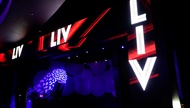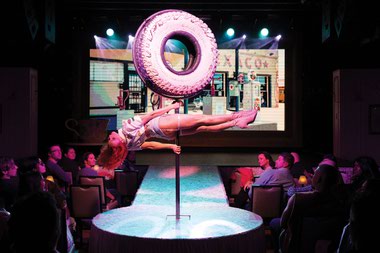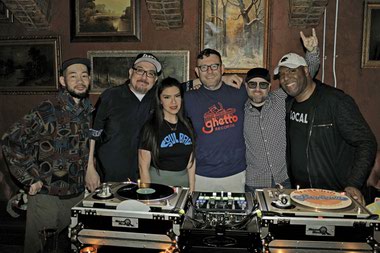Victor Drai darts into the street without so much as a glance down Flamingo Road. He’s just walked out of Bally’s—and the lounge he operates there, Indigo—having discussed how he lives in the moment and doesn’t look ahead too much. But two steps off the curb and onto the notoriously busy thoroughfare, he gives a quick head-swivel, just in time to see a car barreling toward him.
“I’m still French!” he says with a huge smile after jumping back onto the sidewalk. “I hate going to the crosswalks.” Once the vehicle that almost flattened him passes, he resumes jaywalking, completing this round of real-life Frogger with ease, if not grace.
He walks up to the porte cochère of the just-opened Cromwell, talking excitedly, like it’s his or something. It very nearly was; Drai passed on an offer to take over and brand the Caesars Entertainment-owned property so he could focus on his nightlife portfolio instead. After a brief dalliance with boutique hotel company Gansevoort, Caesars christened the former Barbary Coast and Bill’s Gamblin’ Hall with its new name: the Cromwell.
Though the casino isn’t his, there’s no mistaking Drai’s aesthetic signatures once inside: the tasteful but traditional poshness, the understated but chic lounge, the balance of dark and light and, of course, the red. Forget Robert Fripp—Victor Drai is King Crimson.
“It’s funny—now that people know my clubs, if they walk into the Cromwell today, they’ll say, that’s totally Drai.”
He points out the empty space where revelers will queue up for his newest venture, the 65,000-square-foot Drai’s Beach Club and Nightclub, 11 stories up on the Cromwell’s roof. After walking the length of the widened casino corridor, he stops in front of a familiar door—albeit one I’ve never seen cleared of the usual partiers, hosts and security types.
This is where it all started. As Drai answers his phone—ringtone: crickets chirping—I think of my previous graveyard-shift visits. The beckoning of the guest list holder. The descent down the stairwell to the bar at the bottom. The thump of deep house music. The people huddled inside the plush Library—the first place I ever encountered European bottle service. And Drai himself, usually flanked by beautiful women and shoulder-tapping staff.
Just as it should be for a Vegas nightlife game-changer—who’s getting ready to change the game again.
Drai’s Afterhours first opened at Barbary Coast in 1999, but its genesis—as well as those of Drai’s subsequent nightclubs—began six years earlier in LA. Then a movie producer, Drai had wrapped up the sequel to his hit comedy Weekend at Bernie’s, and did the unthinkable: He willingly left show business. About to become a father for the first time and having already made his money in Paris as a fashion designer and then in Hollywood, he was ready to move on. “I fulfilled my dream 20 or 30 years ago,” he says.
Drai uses the word “dream” a lot, especially as a verb. He doesn’t say “imagine” or “think.” His mix of practicality and conception hints at a man who both goes with his gut and taps into his subconscious. His vision—another favorite word—comes simply to him. He might be less of an entrepreneurial mastermind and more of a fantasizer—the ideal person to facilitate a clubber’s escapades.
Drai’s new dream in 1993 was to own a restaurant, where working hours would suit family life, so he opened the first Drai’s on La Cienega Boulevard in Beverly Hills. Success came instantly, as did a Monday night live-music promotion. When he opened a second Drai’s inside the Barbary Coast on the corner of Flamingo and Las Vegas Boulevard in 1997, he planned to give it “a clubby look” to allow for a similar promo, but the Stripside spot had too many customers clamoring for its French cuisine to accommodate post-dinner entertainment. It wasn’t until two years later that he and SoCal/Vegas promoter Tony Verdugo instead launched an afterhours party that would compete with Spearmint Rhino’s popular daybreak affair and Club Utopia’s all-nighters—and outlast them both.
With Utopia’s struggles and the eventual closure of Rhino’s party, as well as Verdugo’s connections, a liberal seating policy that only booted patrons if a table was purchased, and an upscale setting that attracted those who might not have otherwise attended afterhours—especially women—Drai’s quickly became the dominant after-midnight spot in town.
“Victor has a method, a philosophy, for better or worse,” says longtime local nightlife figure Michael Fuller, currently the executive vice president of development at Warner Hospitality. “He also has a knack for bringing in the right people. Love him or hate him, he makes things work and has pushed the envelope to change our city. He absolutely deserves credit to some degree. Most operators would refuse to even bother with afterhours.”
Drai made it his signature. His venue became known for its soundtrack, which took a sharp left turn from nearly every competing club and lured DJs who wanted to be left alone by club management (and club patrons, for that matter). If House of Blues was the de facto training ground for many of today’s most successful club execs, the Drai’s booth helped several local DJs hone their craft.
“Drai’s Afterhours is a very special venue,” says Kris Nilsson, who jumped at the chance to DJ at Drai’s in 2005 despite already having cush gigs at Strip nightclubs, and has remained part of music director Chris Garcia’s 10-man team ever since. “Many professional DJs have come in, played and had a less-than-successful evening. Drai’s Afterhours demands not only excellent music [from its DJs], but also a connection with the crowd that is unlike any other venue. The DJ has to sense the feel of the room before anyone else even knows it’s changing ... I never take this for granted.”
Drai’s Afterhours became such an institution, it survived countless competitors—even those kick-started by defectors—along with a temporary move to Bally’s and a fatal shooting there last October. The party is slated to return to its renovated subterranean home in late June.
Today, Drai is responsible for some 500 employees, most of them training for the May 22 opening of Drai’s Beach Club and Nightclub at the Cromwell. He calls it his biggest dream to date—eclipsing XS, the Encore megaclub he designed and opened in 2009—and the single biggest club project outside of Las Vegas’ existing nightlife management groups.
Drai might be working with Caesars on the rooftop party spot, but he remains an industry outsider. His independence is defined by his vision and the autonomy of his operations.
His staff vouches for his efficient sovereignty, as opposed to the all-hands-on-deck bureaucracy usually found at his more corporate (and casino-influenced) competitors.
“Both systems work,” says Ryan M. Craig, managing partner at Drai’s Management Group. “I prefer this, though, so we can go to the source and ask, ‘Do you like it, yes or no?’ If you’re passionate about something, and you bring it to [Drai’s] attention, he’ll take your side on it. He knows the direction he wants to take the company into.”
He also laments nothing, placing a high value on his self-sufficiency. In 2010, he left XS and Tryst when Steve Wynn began taking a more active role in nightlife. Last year, Drai shuttered Drai’s Hollywood when, he says, host property W Hotel also became too hands-on. “They were bugging me, and I don’t like to be bugged by anybody,” Drai says. When asked if he regrets either the Wynn or the W associations, he shakes his head. “I think things always happen for a reason. I’m very instinctive in life.”
So far, Drai has nothing but praise for “dream partner” Caesars Entertainment. The gaming behemoth has given Drai virtually everything he’s sought—even when it wasn’t aware of it.
An innate knack for identifying opportunity helped Drai unwittingly scout the location for his Beach Club and Nightclub years ago, when he used to watch the Strip’s New Year’s Eve fireworks show from the then-Barbary Coast rooftop.
“I would take my son [up there] every year and say, ‘One day we have to do something here,’” Drai recalls. He initially saw a restaurant or bar crowning the casino building, but power lines hovering too closely above ended that particular dream.
After Caesars acquired the hotel in 2006 and rebranded it Bill’s Gamblin’ Hall, it decided to overhaul the property and move the lines underground. Drai found out and immediately rung Caesars brass, which was receptive to his pitch of a rooftop nightclub. Speed bumps abounded over the next few years, but Drai remained patient, endlessly tweaking his designs. “I always have a vision when I start a club—it needs a wow factor.”
Clubgoers will see his greatest wow when they walk from the 11th-story nightclub out into an aquatic playland surrounded by a breathtaking panorama of the Strip. Drai regards this as his trump card: that the Cromwell, and his venue, sit right atop Las Vegas Boulevard. The vista will literally engulf Drai’s Beach Club partiers, who may spend more time gazing at the unobstructed view of the Bellagio fountains than the immaculate dayclub or its sure-to-be-beautiful patrons.
As for the view from below, Drai teases the dayclub with the most transportive imagery possible, planted in the frame of the pool: rooftop palm trees that have forever “changed the Vegas skyline,” according to 15N Creative consulting firm owner Branden Powers.
Entering the nightclub, attendees will find themselves immediately enveloped by a wraparound LED light wall. All of the indoor space is positioned for an interactive, unobscured, 360-degree experience.
The design is multifunctional. Drai’s blueprints put the nightclub front and center because his primary motivation is always aesthetic. As he puts it, “I want the space to be the star, always.” But interestingly, his strategies also seem to address his gripes with the modern Vegas nightlife experience. There’s the focal-point dance floor that counters the glorified concerts happening in EDM clubs; the wide-open room that aims to reduce the human bottlenecking found at popular Strip spots; and the preference of LED illumination over the traditional bulb beams, lasers and strobes. The lights in particular are burrs under Drai’s saddle. “I’m nuts about lighting—I’m crazy about it,” he seethes. “I’m very sensitive to it.”
It’s hard to imagine a nightclub more personally built, more aligned with its creator than Drai’s. When a corporate nightlife group offers the usual soundbite about “attention to detail,” you can often dismiss it as a marketing trick that relies on repetitiveness and buzzwords. But when Drai talks details and his obsession with them, they actually connect to him and his history.
Victor Drai got an early jump on nightlife at 16, two years after moving to Paris from his native Morocco, where he was born in Casablanca in 1947.
In Paris the legal drinking age is 18, but Drai took advantage of lax liquor laws and permissive parents to slip into clubs two years early (the same year he started his first business, as an exterminator).
“Paris had very cool clubs back then, but they were very small,” he remembers. “I really saw the evolution of the small club, the big club, the gay club ... it was a great education.” It was also an early indicator of his nightlife preferences. From early on, he gravitated toward elegant spaces.
“They weren’t like these [Vegas clubs] with all this light,” he says, getting in another dig. “They were very sophisticated, the lighting was beautiful, the coloring was beautiful. There was a club in Paris called the King, and the couch was so comfortable, it was insane. I never [felt] something so luxurious before. That always stayed in my head. And now, I do the seating [for my clubs], I’m so picky about this sh*t. It’s the memory of that luxury—you don’t expect that in a club.”
He speaks with less enthusiasm about the more casual scene in LA, where he moved in 1976 to spend more time with then-girlfriend actress Jacqueline Bisset. But one spot impressed Drai so much, he now refers to it as “the greatest nightclub ever”: an exclusive supper-club that thrived in the mid-1980s called Helena’s, which only admitted the Hollywood elite and their plus-ones. Its pink lights and candles provided the subtler, more feminine atmosphere to which Drai was partial.
He would later adopt that sense of ambiance and class for Drai’s Afterhours, and their importance to it cannot be overstated. “It was the look,” Drai says. “It was very pretty, it was elegant. It wasn’t like a sh*tty hole you go to at 5 o’clock in the morning to get f*cked up.”
“Victor always gears his environments toward the comfort and security of his female patrons,” adds Powers.
And, if Drai’s experience with nightlife has taught him anything, it’s not to mess with a winning formula. He promises minimal updates for the renovated afterhours spot. “You know, if it works, you don’t touch,” he says.
During one of the first hard-hat tours of Drai’s Beach Club and Nightclub earlier this year, Managing Partner Michael Gruber casually mentioned that once the temporary afterhours operation moved back to the basement of the Cromwell, the Bally’s location would become a gay club, Liaison. This was as much an eye-opener as the view of the Bellagio behind him, or Drai’s own comments 20 minutes later lambasting expensive superstar DJs and the local dance emporiums that book them (more on that in a minute). Who would have predicted that the nightclub magnate famous for dating A-list actresses and entertaining gorgeous women would be the first to develop an LGBT club for a Strip casino?
Only the guy who casually tells a journalist this: “I love a very girly bedroom. The bedroom should be girly. It’s just more fun, know what I mean?”
Of course (giggle).
Drai chuckles too. “When you hear that from a guy like me, you laugh, but it’s true.”
Gay dining rooms and nightspots were among young Drai’s social destinations back in Paris. It was a natural fit, given all the gay friends he had; his own “confidence as a man,” as he puts it; the generally liberal attitude of the thriving Paris club scene in the 1960s; and the aesthetic affinities he shared with queer men, who he found sophisticated—as he did their spaces.
“[Gay restaurants] are more oriented to detail and lighting than the normal restaurants,” he says. “In that sense, they were [influential] to my sensibilities.”
That elegance would characterize every establishment he has owned, including the old Seasons restaurant Drai renovated to host afterhours during the Cromwell’s construction. That space will largely stay the same—save for some new gold touches—when it becomes Liaison this summer because Drai maintains that the clientele will define the club.
“I don’t think I am making a gay club that’s ‘gay,’” he says. “It’s just a beautiful space where we’re catering to gay people, but it’s not a gay club in that sense. We decided to [appeal] to that clientele because I don’t want to do another [mainstream] club here—there’s enough clubs for the straights, and nothing elegant for the gays.”
And there certainly isn’t a dedicated gay hangout at a casino. You can joke that Drai’s past as a young cosmopolitan in Europe, a fashion designer, a professional in the movie business and a West Hollywood restaurateur makes him as good a candidate as any to open an LGBT club, but he’s also a nightlife mover/shaker type who plays by his own rules and breaks others. Luckily, he has an enabling partner in Caesars, arguably one of the most gay-friendly companies in America. That alone should assuage hesitant gay revelers who might question the integrity of a queer club owned by a heterosexual man, which Drai finds illogical. “It’s like saying to be a cook, you have to be a guy or a girl.”
Drai has bolstered Liaison’s bona fides by hiring Eduardo Cordova—a Las Vegas party promoter long associated with the LGBT community, of which he’s openly a member—as the club’s creative partner in charge of programming and imbuing the neutral space with a gay flair. Cordova, who has partnered with several casino nightspots for his gay promotions, sees Liaison as transformative.
“The importance of having a gay nightclub in a major hotel/casino on the Strip is huge,” he says in a statement. “It validates equality and demonstrates just how far we have progressed culturally. This has been the moment that I’ve been working toward for all these years, and it’s exciting to see gay nightlife changing in such a big way.”
Fifteen years after the axis-shift of his afterhours program, Drai has the potential to play game-changer again. Where the Vegas industry syndicate has only dipped its toes into LGBT-nightlife waters, Drai is jumping in cannonball-style with an exclusively gay club.
As much as Drai can be heralded for Liaison, he readily admits that it’s a good business move. He’s also none too shy about his thoughts on the business of EDM.
Back in February, Drai said, “The mega-clubs have become nothing more than large music venues for million-dollar DJs.” During that winter construction-site tour, he ridiculed clubs for allegedly booking $400,000 headliners and only making 15 or 20 percent profit from the night.
He’s not alone in his dismay. Powers, who used to book DJs and electronic acts at raves, is also over the reliance on superstar-DJ programming. Like Drai, he believes the deep-pocketed casinos enable their nightclubs to throw outrageous sums of money at names like Calvin Harris, Avicii and Diplo.
“Nightclubs inside casinos will always benefit from the thousands of rooms above their heads, their massive marketing budgets and the ungodly amounts of money they throw at their mediocre artists,” he says. “This formula is unsustainable. It’s a house of cards that will ultimately fall. You can’t just open a pretty box and expect the world to come any more. You can’t just book the same ‘mega’ DJs every week and expect that to continue to draw.”
The Drai team also sees the eventual bursting of the DJ bubble. “I’ve been here 11 years, and every three years, the music, the dress and the language adapts and evolves,” Craig says. “We’re on the end of the three years time for the DJs representing the venues.”
Early this year, Drai hired Alex Soifer as talent buyer for the Beach Club and Nightclub. His directive: sign less-expensive talent that is nonetheless relevant and musically diverse. Soifer, who came from a big agency, felt a little weird about not going after the superstars. “But the more I got to know Victor and the team, and actually moved to Vegas and understood what was going on here and where people’s profit margins and bottom lines were, I became more confident in what Victor has planned,” he says. “It really takes creativity to have your finger on the pulse of what’s coming next, and Victor definitely was looking forward to the future when he was designing this club and coming up with overall talent strategy.”
That strategy includes producer/DJs who are on the cusp of a breakthrough or commercial crossover, like progressive house icon Eric Prydz, rising electro-house duos Adventure Club and Showtek, and Vegas-born big-room upstart Justin “3lau” Blau, who agreed to Soifer’s pitch within minutes of stepping onto the Cromwell rooftop.
The talent roster had to eschew those DJs accustomed to getting all the club’s attention, and instead serve as a complement to the space’s all-encompassing proposition. Much like the 360-degree visual setup, the DJ is just another component to shift the focal point to the club and the party. And if people are actually dancing, there’s a bigger chance for a more communal convergence. “It’ll happen organically if you can place people in the right position,” Craig says.
“It will be a new social experience,” Soifer says. “We’re bringing it back to people in the room, not people standing with their cameras out trying to snap a picture of a DJ they can barely see.”
Of course, someone has to pay for this $100 million endeavor, and it’s not going to be Joe Clubber, whose idea of a revolutionary nightclub likely differs from that of Team Drai. Craig maintains that if someone racking up a $100,000 booze tab wants to hear an AC/DC song, the DJ can’t be uppity and refuse the request. It’s one part of a giant push to make VIPs feel like they’re getting perks (elaborate bottle presentations! fireworks packages!) and customer service they can’t get elsewhere.
And shifting focus from the talent to the party or club may sound ballsy at a time when EDM is peaking, but it’s not new to Las Vegas, if one recalls the central dance floors of Privé and Light, or even music-driven spaces like Utopia and Jet’s 3400 Destination House room, where you might go for the DJ, but the room’s energy inhibited you from fixating on him.
Seasoned nightlifers may be skeptical that the Beach Club and Nightclub will offer anything truly novel and creative, and observers like Powers don’t expect discerning clubbers to flock to the new venue just because Victor Drai is a less corporate operator. But he gives Drai some benefit of the doubt, especially given the dominance of his afterhours program. “Everyone will check it out once,” Powers says. “Let’s see if he does something new to really keep the crowd.”
It’s easy to visualize a post-EDM scramble to capture the imagination of revelers both visiting and local. Drai is ultimately betting on traditionalism. While some of the “experiential” marketing smacks of the usual Vegas audacity and VIP pandering, there’s something to be said for fostering a social environment that emphasizes the original appeal of nightlife: people meeting, frolicking and living it up in a carefree, escapist environment.
And so Drai once again offers an alternative to, if not a complete break from, the status quo. His nightclub might still look and sound like one, but it’s designed to envelope you and impede the usual distractions, with a DJ good enough to move you without monopolizing your sensory intake. And then there’s the romantic potential of the dayclub overlooking the most famous street and water ballet in the world, shaded by skyward palms delivered by cranes.
Traditional, but still audacious—just like Las Vegas, and just like Victor Drai himself.












